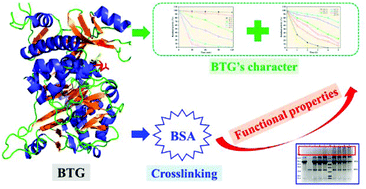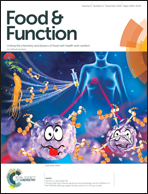Characterization of transglutaminase from Bacillus subtilis and its cross-linking function with a bovine serum albumin model
Abstract
Finding new crosslinking enzymes for enzyme-mediated protein conjugation is a great need in the food industry. In this research, the properties of Bacillus subtilis transglutaminase (BTG) were characterized in detail and its protein crosslinking functions with bovine serum albumin (BSA) as a model were studied. Compared to the commercial transglutaminase from Streptoverticillium mobaraense, BTG was more stable in a broad range of temperatures (30–60 °C) and pH values (pH 5.0–9.0), with its maximum enzymatic activity at 60 °C and pH 8.0. The protein function evaluation results demonstrated that the BTG-modified BSA showed better emulsifying and foaming properties (p < 0.05) compared with the native one. Additionally, significant improvements (p < 0.05) were observed in the rheological properties, water holding capacity, and textural properties of the BTG-treated BSA gels. With good thermal and pH stability and excellent crosslinking effects, BTG would be a potential enzyme for food structure engineering to improve the functional properties of food proteins and expand their applications.



 Please wait while we load your content...
Please wait while we load your content...